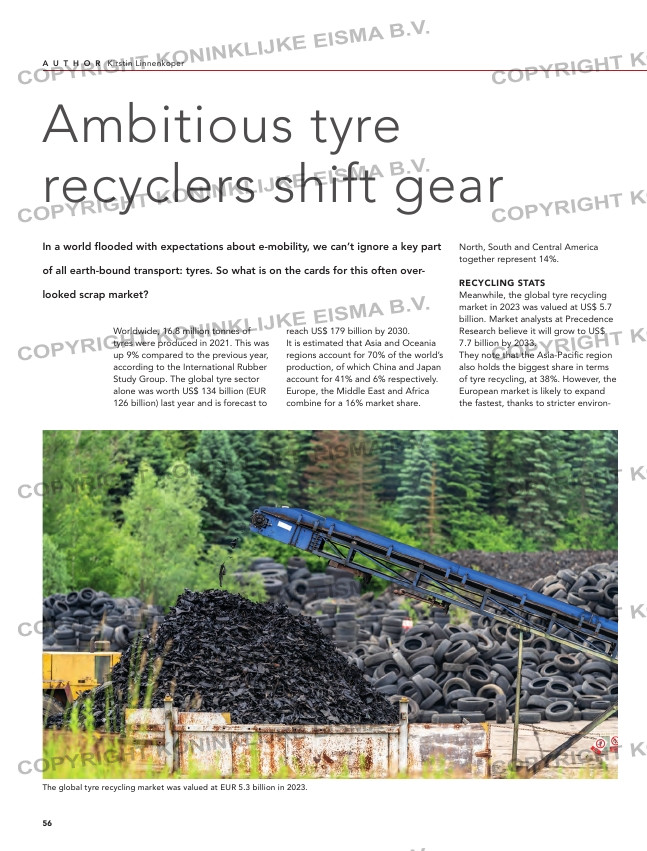Page 56 from: What’s inside?

56
Ambitious tyre
recyclers shift gear
In a world flooded with expectations about e-mobility, we can’t ignore a key part
of all earth-bound transport: tyres. So what is on the cards for this often over-
looked scrap market?
mental legislation.
The continent generates around 300
million tonnes of used car and truck
tyres a year, according to the
European Tyre and Rubber
Manufacturers’ Association. At least
90% of these end-of-life tyres (ELTs)
are reused in some way. Around 50%
currently goes for mechanical recycling
while about 40% is incinerated to gen-
erate energy. Recycling rates fluctuate,
though some member states consis-
tently perform far below the desired
level.
In contrast, the US discards roughly
280 million tyres a year, which repre-
sents about one tyre per person. The
nation boasts a 71% recycling rate,
although only around 20% involves
mechanical treatment. Landfilling is
still a common practice, with energy
recovery picking up steam.
By application, the automotive seg-
ment generated the highest revenue
share, at 40%. The construction seg-
ment is expected to witness the fast-
est growth (nearly 5%) in the coming
years.
END-OF-LIFE POTENTIAL
Most recycled tyre waste – 70% – is
ground down to produce rubber gran-
ules and powder, with much of this
used on artificial sports pitches and on
playground surfaces. The rest is incor-
porated into cement or used for civil
engineering projects. Popular applica-
tions include coastal erosion barriers
and sound barriers. Shredded tyres are
commonly used in foundations for
roads and railways.
Researchers and tyre manufacturers
are eager to produce higher-value
products from the scrap. One example
is Italy’s innovative Life Green Vulcan
project, which aims to revolutionise
tyre recycling and reuse thanks to a
‘selective’ and environmentally friendly
rubber devulcanisation process. The
complex method not only extracts
materials from ELTs, it also has the
potential to replace virgin rubber used
in tyre production.
The output is turned into compounds
which are used to manufacture new
tyre treads and spring pads in vehicle
suspensions systems. Life Green
Worldwide, 16.8 million tonnes of
tyres were produced in 2021. This was
up 9% compared to the previous year,
according to the International Rubber
Study Group. The global tyre sector
alone was worth US$ 134 billion (EUR
126 billion) last year and is forecast to
reach US$ 179 billion by 2030.
It is estimated that Asia and Oceania
regions account for 70% of the world’s
production, of which China and Japan
account for 41% and 6% respectively.
Europe, the Middle East and Africa
combine for a 16% market share.
North, South and Central America
together represent 14%.
RECYCLING STATS
Meanwhile, the global tyre recycling
market in 2023 was valued at US$ 5.7
billion. Market analysts at Precedence
Research believe it will grow to US$
7.7 billion by 2033.
They note that the Asia-Pacific region
also holds the biggest share in terms
of tyre recycling, at 38%. However, the
European market is likely to expand
the fastest, thanks to stricter environ-
A U T H O R Kirstin Linnenkoper
The global tyre recycling market was valued at EUR 5.3 billion in 2023.
56-57-58-60-61-62_tyrestrendsbestpractices.indd 56 25-04-2024 09:35



